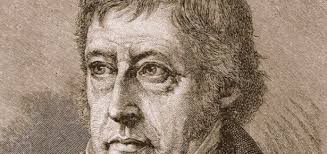
Hegel’s Master/Slave Dialectic In the Phenomenology of Spirit
Hegel’s Phenomenology of Spirit (first published in 1807) is a work in German Idealism that purports to tell the story of the development of the human spirit through a history of consciousness. In the section on “Self-Consciousness” in which the Master/Slave dialectic is found, we find an abstract, universal consciousness bifurcated and faced with another consciousness just like itself. Each face of consciousness wanting recognition of itself as the original and unique form of consciousness, a battle onto death ensues, the result of which are two kinds of self-consciousnesses — the Master and Slave consciousnesses.
The Master
The Master consciousness decides that the most important value is that of freedom — without freedom, life is not worth preserving. The Slave makes the opposite judgement, deciding freedom is worthless if one’s life is lost. Therefore the conflict between the two consciousness is resolved as each takes up different kinds of consciousness, each embodying the recognition of the One as the Master and the Other as the Slave. It is an asymmetrical relation of difference that inaugurates self-consciousness.
Initially, it looks like the Master has won the day and that the dialectic of spirit will continue from the perspective of the Master. But soon enough, a contradiction emerges: Once the other consciousness emerges as Slave, it can no longer provide the Master with the recognition it initially desired, a recognition that is essential to their mastery. Also, the life of the Master rapidly devolves into one of dependence on the Slave, who provides the Master with all of life’s necessities and anticipates their desires. In other words, the Master’s life becomes one of pure and unfettered consumption and enjoyment. A glutton, the Master's life comes to be about the unending satisfaction of fleeting desires.
The Slave
The Slave’s life is ruled by the Master’s needs an desires, which the Slave must learn to anticipate as a matter of survival. But a funny thing starts to happen: in making all the things needed to maintain the Master’s life and to satisfy the Master’s insatiable desires, another reality opens. In the course of their work, in working upon the materials of the world, the Slave opens up a reality that is independent from that of the Master, who could not care less about the conditions for the production of those goods. The slave gains knowledge about the world that the Master does not have, and therefore becomes increasingly independent.
The slave also sublimates their identity through work — that piece of furniture that is made by them, they conceived of it and made their idea concrete. Thus, the Slave finds meaning in and through their labor (a point that will be carried forward by Marx and Engels), just as the Master’s life is devolving into meaningless consumption. Increasingly, the slave takes over the role of independent self-consciousness.
The tables are getting ready to be turned. When the Slave comes to realize that the Master is dependent on their labor for their very existence - that is, having to come to consciousness as essential to the Master - he comes to make a claim for recognition from the Master. In the end a bargain is struck, an economic solution to the contradiction that began with the production of two asymmetrical self-consciousnesses: two mutually dependent self-consciousnesses emerge as two parts of an original unity called (human) spirit.
Hegel’s Logic: Thesis, Anti-Thesis, and Synthesis
Hegel’s Master/Slave dialectic is a great example of the overall work’s logical structure of thesis, anti-thesis, synthesis — you may have heard this about Hegel’s work. The original thesis is the existence of an abstract, universal, undifferentiated consciousness with which the section begins. This unity is bifurcated into two, creating the opposition between Master and Slave consciousnesses — this is the moment of negation when antithesis emerges.
The contradiction or opposition between the Master and the Slave contains the seeds of it’s own destruction. It is inevitable that the Slave comes to realize his independence, and then a resolution emerges by which two are again unified as co-constituted and mutually dependent self-consciousnesses. Thus, through synthesis, Hegel arrives back to the unity of a thesis and the dialectic is ready to take another turn.
Hegel's account of the co-emergence of asymmetrical difference has inspired many accounts of difference. It is the basis for Marx's account of class, Beauvoir (and other feminist) accounts of sex and gender difference, and Fanon's accounts of racialized identities under colonialism. In short, all socio-political differences are underpinned by the dynamics so well described by Hegel in his Phenomenology of Spirit.
☟I invite your questions below ☟
Resources
The Bernstein Tapes — Hegel’s Phenomenology of Spirit [audio lectures]
The Struggle for Recognition, Axel Honneth (1992)
Riddle of Self, Mikhailov (1976)
Excerpt from Hegel for Beginners
This article is Part 2 of the series that begins here: The Other Who Troubles Philosophy.
☞ The next blog post in this series is Merleau-Ponty On Other Selves and the Human World
This article was originally published on my Medium blog.
Nice article! You did a good job of explaining the master/slave dialectic.
Downvoting a post can decrease pending rewards and make it less visible. Common reasons:
Submit
♫ Thanks! I'm glad you enjoyed it. This is part of a series, so we'll add more understanding as we progress through the series.
Downvoting a post can decrease pending rewards and make it less visible. Common reasons:
Submit
Hi! I am a robot. I just upvoted you! I found similar content that readers might be interested in:
https://medium.com/@tPhilosophia/hegels-master-slave-dialectic-in-the-phenomenology-of-spirit-4ef9f61f541d
Downvoting a post can decrease pending rewards and make it less visible. Common reasons:
Submit